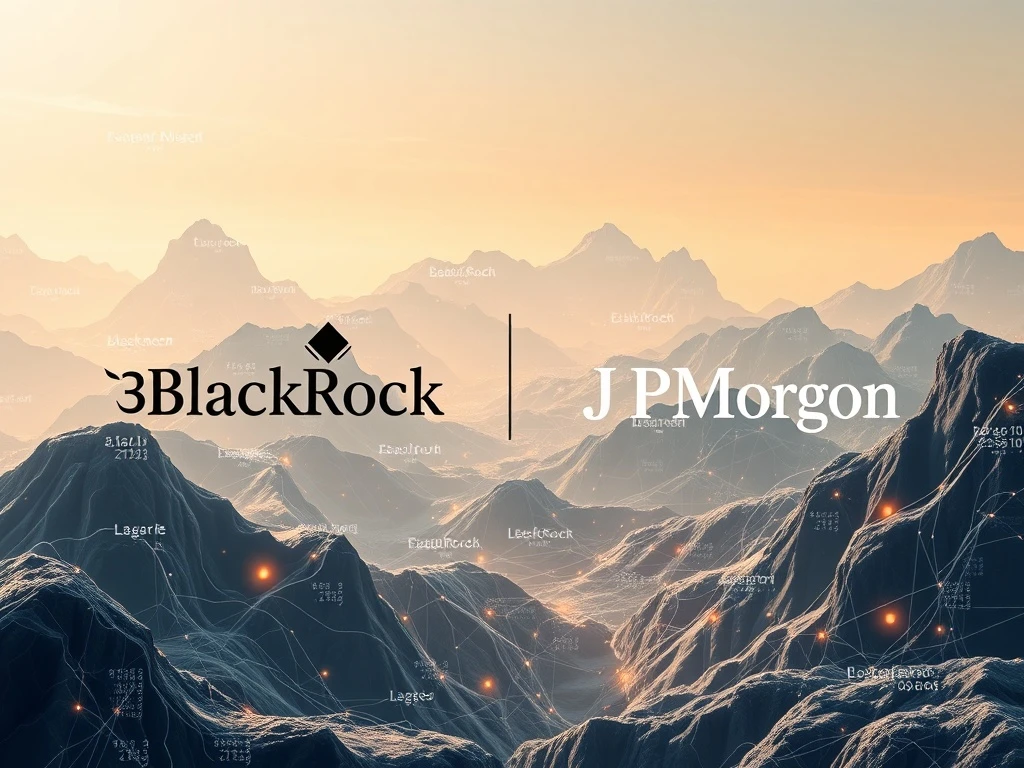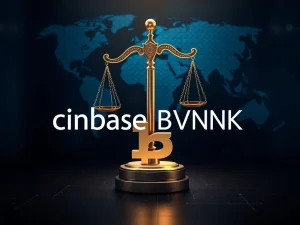BlackRock’s **Pivotal** Move: **ETF Tokenization** Signals a New Era in Digital Assets Finance

The financial world stands on the cusp of a revolutionary transformation. Indeed, major players like BlackRock are actively exploring **ETF tokenization**, a move that could redefine how investments operate. Following the immense success of its spot Bitcoin ETFs, the world’s largest asset manager now eyes the broader application of blockchain technology to traditional financial products. This strategic shift is not happening in isolation. Instead, it aligns with a growing industry consensus, championed by institutions like JPMorgan, which consistently flags tokenization as a game-changer for the entire financial sector. Investors and industry watchers alike are keenly observing these developments, recognizing their potential to unlock unprecedented efficiency and accessibility within **digital assets finance**.
BlackRock Tokenization: Embracing the Blockchain Frontier
BlackRock, a titan in asset management, is reportedly delving into the tokenization of exchange-traded funds (ETFs) on the blockchain. This exploration follows the impressive performance of its spot Bitcoin ETFs, which demonstrated significant market demand for digitally native investment vehicles. Sources familiar with the discussions, as reported by Bloomberg, indicate the company is considering tokenizing funds with exposure to real-world assets (RWA). Such an initiative would, however, necessitate navigating complex regulatory landscapes. ETFs have become a cornerstone of modern investing, now even outnumbering publicly listed stocks, according to Morningstar data. Tokenizing these popular instruments could introduce numerous benefits. For example, it could allow them to trade beyond conventional market hours. Furthermore, it might enable their use as collateral in decentralized finance (DeFi) applications, opening new avenues for liquidity and capital efficiency.
BlackRock’s interest in tokenization is certainly not a recent development. The firm already manages the BlackRock USD Institutional Digital Liquidity Fund (BUIDL), which stands as the world’s largest tokenized money market fund. BUIDL boasts over $2.2 billion in assets and operates across multiple blockchains, including Ethereum, Avalanche, Aptos, and Polygon. This existing infrastructure demonstrates BlackRock’s commitment and growing expertise in the digital asset space. The firm’s proactive stance underscores a broader trend. Traditional finance institutions are increasingly recognizing the transformative potential of blockchain technology. They are not merely observing; they are actively participating in shaping the future of finance.
JPMorgan Blockchain Insights: Acknowledging a Paradigm Shift
JPMorgan has consistently championed tokenization as a significant advancement for the financial industry. They describe it as a ‘significant leap’ for the immense $7 trillion money market fund sector. This perspective gains further weight from initiatives like the one launched by Goldman Sachs and Bank of New York Mellon, which BlackRock is poised to join. Under this collaborative framework, BNY clients will gain direct access to money market funds. Share ownership for these funds will be registered directly on Goldman Sachs’ private blockchain. This move by major financial players signals a clear endorsement of blockchain’s capabilities for traditional financial products. It represents a tangible step towards integrating distributed ledger technology into core banking operations.
The rise of tokenized money market funds is not occurring in a vacuum. It responds to mounting pressures on traditional finance, particularly from the rapid adoption of stablecoins and the shift of liquidity towards blockchain-based markets. In May, Crypto News Insights highlighted that the US banking lobby expressed significant apprehension regarding yield-bearing stablecoins. These concerns stemmed from fears that such tokens could disrupt established banking models. Notably, the US GENIUS Act, the first comprehensive stablecoin legislation, explicitly excluded these tokens. This legislative exclusion reflects the ongoing tension between traditional financial structures and the burgeoning digital asset ecosystem. Yet, it also underscores the need for clearer regulatory frameworks to foster innovation responsibly.
JPMorgan strategist Teresa Ho provided further insights in June. She stated that tokenized money market funds will likely continue attracting capital to the industry. Furthermore, they will enhance their appeal as collateral. This development, she noted, could help preserve ‘cash as an asset’ against the growing influence of stablecoins. Ho explained to Bloomberg, ‘Instead of posting cash, or posting Treasurys, you can post money-market shares and not lose interest along the way. It speaks to the versatility of money funds.’ This perspective highlights a key advantage of tokenized assets: their ability to maintain utility and generate yield even when used as collateral. It’s a significant improvement over traditional methods where collateral often remains idle.
ETF Tokenization: Unlocking New Possibilities for Investors
The concept of **ETF tokenization** promises to revolutionize how investors interact with exchange-traded funds. By representing ETF shares as digital tokens on a blockchain, several groundbreaking benefits emerge. First, tokenized ETFs could potentially facilitate 24/7 trading. This extends beyond traditional market hours, offering unparalleled flexibility to global investors. Imagine trading an ETF at any time, day or night, regardless of geographic location. This capability could significantly enhance market liquidity and responsiveness. Second, tokenization enables fractional ownership. This means investors could buy a small fraction of an ETF share, making high-value funds more accessible to a broader range of retail investors. This lowers the barrier to entry for diversified portfolios.
Moreover, tokenized ETFs could seamlessly integrate into decentralized finance (DeFi) ecosystems. They could serve as collateral for loans, participate in liquidity pools, or be used in various other DeFi protocols. This interoperability could unlock new yield opportunities and increase the utility of ETF holdings. The transparency inherent in blockchain technology also offers benefits. All transactions are immutably recorded, enhancing auditability and reducing the potential for fraud. However, the path to widespread adoption of tokenized ETFs is not without its hurdles. Regulatory clarity remains a primary concern. Jurisdictions worldwide are grappling with how to classify and oversee these innovative financial products. Addressing these regulatory challenges will be crucial for fostering trust and encouraging mainstream adoption.
The potential for enhanced efficiency is another compelling aspect of **ETF tokenization**. Traditional ETF operations involve multiple intermediaries, leading to complex settlement processes and higher costs. Blockchain technology can streamline these processes. It can reduce the number of intermediaries, thereby lowering operational expenses and accelerating settlement times. This efficiency gain could translate into lower fees for investors and improved overall market performance. As such, the move towards tokenized ETFs is driven by both innovation and the pursuit of greater operational effectiveness within the financial system. It represents a significant step towards a more digitized and interconnected global financial infrastructure.
RWA Tokenization: Bridging Traditional Assets and Blockchain
The broader trend of **RWA tokenization** (Real-World Asset tokenization) underpins the efforts seen with ETFs and money market funds. RWA tokenization involves converting ownership rights of tangible and intangible assets into digital tokens on a blockchain. These assets can range from real estate and art to commodities and private equity. This process essentially brings illiquid assets onto the blockchain, making them more accessible, divisible, and tradable. For example, a multi-million dollar property could be tokenized, allowing investors to buy fractional ownership stakes, which were previously impractical. This significantly broadens the investment landscape and democratizes access to traditionally exclusive asset classes.
The benefits of RWA tokenization are multifaceted. Firstly, it enhances liquidity. Assets that were once difficult to sell or transfer can become highly liquid, trading on secondary markets 24/7. Secondly, it reduces administrative costs and complexities associated with traditional asset transfers. Blockchain’s immutable ledger ensures transparency and reduces the need for extensive due diligence on ownership records. Thirdly, it offers greater transparency. All ownership transfers and transactions are recorded on a public or permissioned ledger, providing an auditable trail. Finally, it enables fractionalization, making high-value assets accessible to a wider pool of investors, as previously mentioned with ETFs.
The BlackRock USD Institutional Digital Liquidity Fund (BUIDL) serves as a prime example of successful RWA tokenization in action. Its rapid growth and multi-chain deployment demonstrate the viability and demand for tokenized traditional financial products. As seen in data from RWA.xyz, BUIDL’s market capitalization has grown significantly across various networks. This success story provides a blueprint for other financial institutions considering similar ventures. However, the regulatory landscape for RWA tokenization remains fragmented. Different jurisdictions are developing varied approaches, creating a complex environment for global implementation. Clear, consistent regulations will be vital for the widespread adoption and scaling of RWA tokenization across diverse asset classes.
The Future of Digital Assets Finance: Intersecting Innovation and Regulation
The burgeoning field of **digital assets finance** is at a critical juncture. The convergence of traditional financial giants like BlackRock and JPMorgan with blockchain technology is creating unprecedented opportunities. However, it also presents significant challenges, particularly in the realm of regulation. The drive towards tokenization, whether for ETFs, money market funds, or other real-world assets, fundamentally aims to enhance efficiency, transparency, and accessibility in financial markets. Yet, achieving these goals requires a delicate balance between fostering innovation and ensuring investor protection and market stability. Regulators globally are actively engaged in developing frameworks that can accommodate these new technologies while mitigating potential risks. This ongoing dialogue between innovators and policymakers will shape the trajectory of digital finance for years to come.
Analysts suggest that stablecoin growth, particularly under clearer legislative frameworks like the GENIUS Act, will ultimately benefit the broader tokenization movement. Such legislation provides stronger on-ramps into blockchain markets and establishes clearer rules for digital assets. This regulatory clarity is essential for institutional adoption and for building confidence among mainstream investors. The move towards regulated multicurrency stablecoins, for instance, could even challenge the dollar’s crypto monopoly, fostering a more diverse and resilient digital financial ecosystem. The transformation underway in **digital assets finance** is comprehensive, touching upon every aspect from investment vehicles to market infrastructure. It promises a future where financial services are more integrated, efficient, and globally accessible, driven by the immutable power of blockchain technology.
The developments spearheaded by BlackRock and endorsed by JPMorgan underscore a powerful narrative: blockchain is no longer a fringe technology. Instead, it is becoming an indispensable tool for the evolution of global finance. As these major institutions continue to explore and implement tokenization strategies, the financial landscape will undoubtedly undergo a profound and lasting metamorphosis. Investors, therefore, should remain informed and prepared for a future where digital assets and traditional finance are inextricably linked, offering novel opportunities and reshaping established paradigms.






